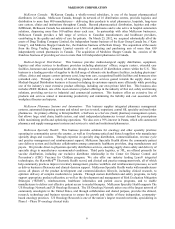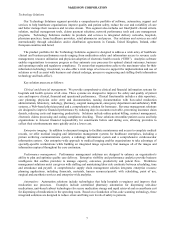McKesson 2012 Annual Report Download - page 20
Download and view the complete annual report
Please find page 20 of the 2012 McKesson annual report below. You can navigate through the pages in the report by either clicking on the pages listed below, or by using the keyword search tool below to find specific information within the annual report.McKESSON CORPORATION
16
Medical Billing and Coding: Medical billing, coding and collection activities are governed by numerous federal
and state civil and criminal laws. In connection with these laws, we may be subjected to federal or state government
investigations and possible penalties may be imposed upon us, false claims actions may have to be defended, private
payers may file claims against us and we may be excluded from Medicare, Medicaid or other government-funded
healthcare programs. Any such proceeding or investigation could have a material adverse impact on our results of
operations.
Changes in the Canadian healthcare industry and regulatory environment could have a material adverse impact
on our results of operations.
The provincial governments in Canada provide partial funding for the purchase of pharmaceuticals and
independently regulate the sale and reimbursement of drugs. Similar to the United States, the Canadian healthcare
industry has undergone significant changes in recent years in an effort to reduce program costs. For example, in
2006 the Ontario government significantly revised the drug reimbursement system with the passage of the
Transparent Drug System for Patients Act. In recent years, to reduce the cost for taxpayers, various provinces took
further steps to reform the rules regarding the sale of generic drugs. These changes include the significant lowering
of prices for generic pharmaceuticals and, in some provinces, the elimination or reduction of professional
allowances paid to pharmacists by generic manufacturers. These reforms may adversely affect the distribution of
drugs as well as the pricing for prescription drugs for the Company’s operations in Canada. Other provinces are
considering similar changes, which would also lower pharmaceutical pricing and service fees. Individually or in
combination, such changes in the Canadian healthcare environment may significantly reduce our Canadian revenue
and operating profit.
Competition may erode our profit.
In every area of healthcare distribution operations, our Distribution Solutions segment faces strong competition,
both in price and service, from national, regional and local full-line, short-line and specialty wholesalers, service
merchandisers, self-warehousing chains, manufacturers engaged in direct distribution, third-party logistics
companies and large payer organizations. In addition, this segment faces competition from various other service
providers and from pharmaceutical and other healthcare manufacturers as well as other potential customers of the
segment, which may from time-to-time decide to develop, for their own internal needs, supply management
capabilities that would otherwise be provided by the segment. Price, quality of service, and in some cases,
convenience to the customer are generally the principal competitive elements in this segment.
Our Technology Solutions segment experiences substantial competition from many firms, including other
software services firms, consulting firms, shared service vendors, certain hospitals and hospital groups, payers, care
management organizations, hardware vendors and internet-based companies with technology applicable to the
healthcare industry. Competition varies in size from small to large companies, in geographical coverage and in
scope and breadth of products and services offered. These competitive pressures could have a material adverse
impact on our results of operations.
A material reduction in purchases or the loss of a large customer or group purchasing organization, as well as
substantial defaults in payment by a large customer or group purchasing organization, could have a material
adverse impact on our financial condition, results of operations and liquidity.
In recent years, a significant portion of our revenue growth has been with a limited number of large customers.
During 2012, sales to our ten largest customers accounted for approximately 52% of our total consolidated revenues.
Sales to our two largest customers, CVS and Rite Aid, accounted for approximately 16% and 10% of our total
consolidated revenues. At March 31, 2012, accounts receivable from our ten largest customers were approximately
49% of total accounts receivable. Accounts receivable from CVS, Walmart and Rite Aid were approximately 17%,
10% and 9% of total accounts receivable. As a result, our sales and credit concentration is significant. We also
have agreements with group purchasing organizations (“GPOs”), each of which functions as a purchasing agent on
behalf of member hospitals, pharmacies and other healthcare providers, as well as with government entities and
agencies. A material default in payment, change in our customer mix, reduction in purchases, or the loss of a large
customer or GPO could have a material adverse impact on our financial condition, results of operations and
liquidity.
























